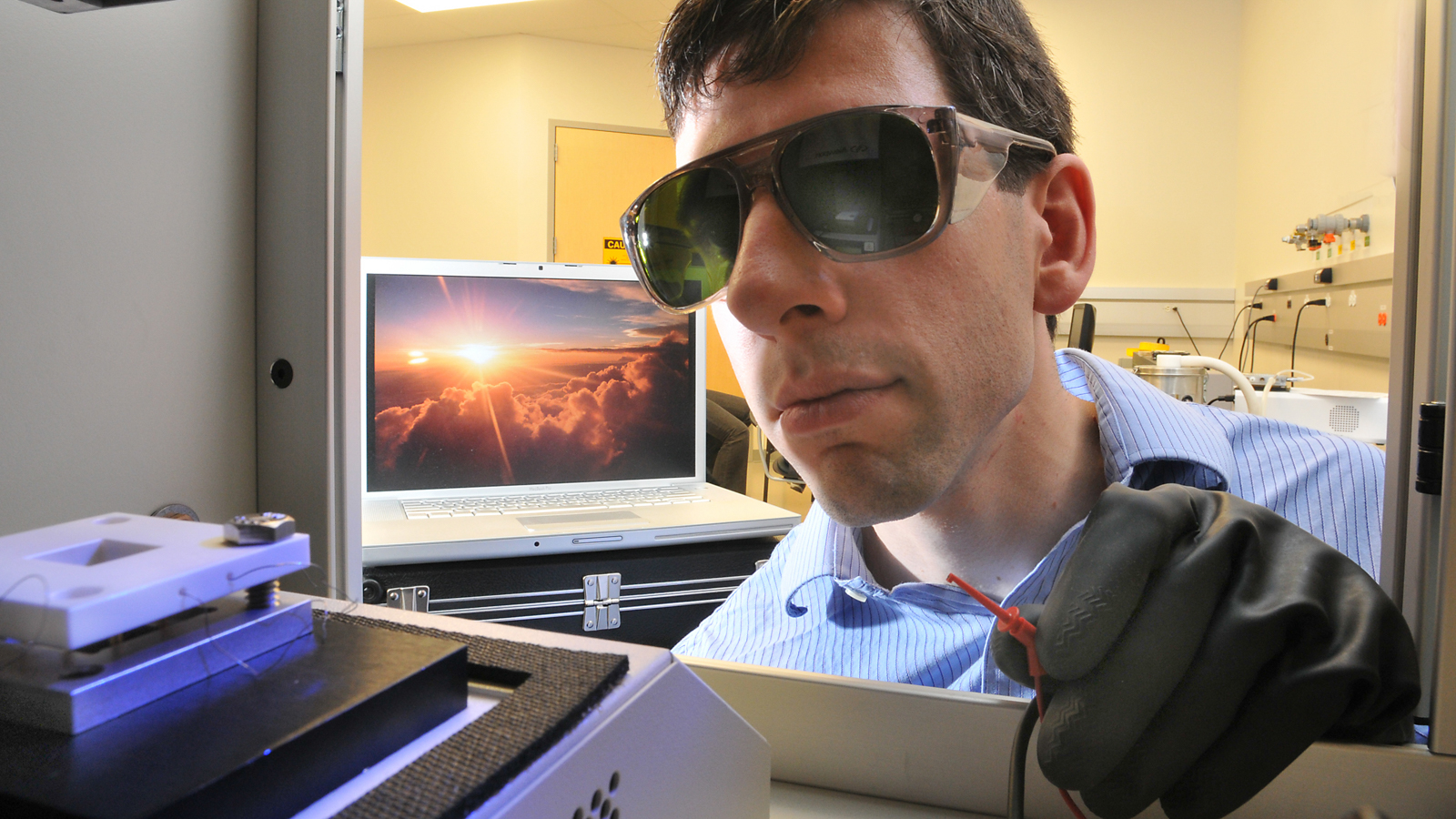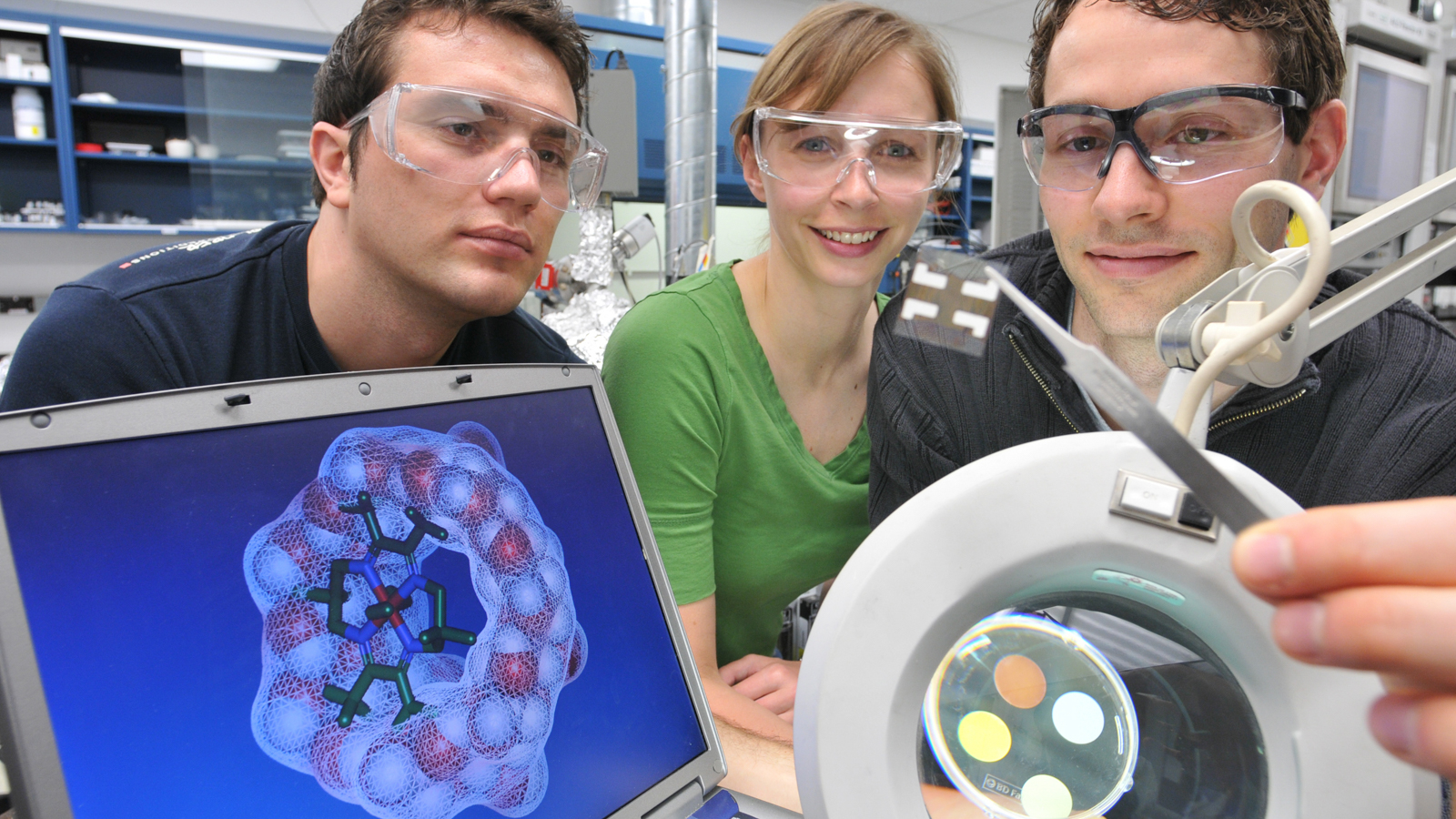
Every year the Earth receives many times more energy from the sun than humanity needs to power all of its industries, infrastructure, homes, vehicles, and appliances. Scientists have only just begun to investigate a variety of different approaches for harvesting this energy more efficiently and cheaply, and Argonne researchers from many disciplines—nanotechnology, materials science and basic physics—have come together to find ways to make solar energy as commercially attractive as fossil fuels.
Solving America’s energy challenges will require contributions from many different energy technologies, but one form of energy holds special promise because it is both abundant and also virtually pollution-free: solar power.
In one hour, more solar energy falls on the Earth’s surface than the whole world uses in a year. “If you thought of powering America as trying to fill a swimming pool,” said Argonne materials scientist George Crabtree, “then the energy from the sun’s rays would give you enough to fill Lake Michigan.”
To develop its capabilities in solar energy research, Argonne has brought together expertise from across the laboratory and from partner institutions to form a unified systems approach to solar energy. An additional collaboration between the laboratory and Northwestern University has also taken root as part of the U.S. Department of Energy’s Energy Frontier Research Center initiative. The Argonne-Northwestern Solar Energy Research Center (ANSER) brings together scientists to understand and control the chemical processes and materials necessary to obtain cheap, efficient and clean solar energy. Researchers at ANSER investigate converting solar energy to both electricity and to fuel.
Solar panels convert sunlight to electricity through the photovoltaic effect, a process by which a semiconducting material absorbs energy-carrying photons, which are “bundles” of light. Once absorbed by the semiconductor, these photons knock loose electrons, leaving behind a region of positive charge called a “hole.” The electron and hole move in opposite directions through a circuit, creating electricity.
The vast majority of the initial research in solar cell technology focused on crystalline silicon, one of the most common and efficient semiconductors for photovoltaics. Even under optimal conditions, however, a perfect single-junction silicon crystal could convert sunlight to electricity at an efficiency of only about 30 percent. The prohibitive cost of systems based on these single-junction crystals – which cost approximately $10 per watt – prevents them from being competitive with fossil fuels, which provide power at roughly $2 a watt when capital costs are taken into account.
“Silicon is already almost as efficient as it can be,” said Argonne nanoscientist Seth Darling, who is Argonne’s solar strategy leader. “The reason we’re not putting them on roofs everywhere is that they’re just so expensive. Silicon and other current technologies by themselves are never going to be cost-competitive with fossil fuels on a global scale.”
In order to eventually provide clean solar energy at a cost close to that associated with fossil fuels, scientists need either to improve the efficiency of their solar cells or dramatically cut the cost of the materials and processes needed to produce them. As a result, scientists from around the world have begun to investigate a number of materials that could help to promote the photovoltaic effect.
“Photovoltaic cells are just one piece of the solar puzzle.” –Seth Darling
Most of these newer and cheaper substances – which range from photosensitive dyes incorporated in oxide nanomaterials to organic or inorganic thin films – convert sunlight much less efficiently than crystalline silicon-based solar cells. According to Argonne Distinguished Fellow Michael Pellin, the cost savings associated with the use of these technologies can compensate for their lower efficiencies, but the sheer land area required for enough of these solar cells to completely replace fossil fuels prevents their immediate adoption.
“If you wanted to satisfy all of the country’s energy needs with 10-percent-efficient solar cells, you’d need to produce and install panels that would cover an area equal to that of all the federal highways in America,” Pellin said. “We’ve taken on projects of a similar scale before, but it would obviously be extraordinarily difficult.”
One of the major complications that dramatically reduces the efficiency of low-cost solar cells involves the short life-span of the electron-hole pair, also known as an “exciton.” In order for the two constituent charges of the bound exciton to successfully separate and produce electricity, the two opposing regions of semiconducting material – one conducts electrons, the other holes – have to be within 10 nanometers of each other. Otherwise, the material will lose the energy it had just absorbed.
Simply stacking two ultrathin layers of semiconductors, however, would create solar cells that would not absorb as many photons. To satisfy the exciton’s requirement for closely packed layers of semiconducting material, Argonne’s materials scientists are perfecting various techniques for controlling the three-dimensional nanoscale structure within low-cost photovoltaic materials.
One such approach is called atomic layer deposition, which allows Argonne’s nanoscientists to precisely place thin films of conducting oxides and semiconducting materials on the inside of nanoporous membranes. The interspersing of the different semiconductor types enables many more of the excitons to split, improving the material’s electrical efficiency.
The utility of solar energy does not begin and end merely with the creation of new photovoltaic materials. In his work as the solar strategy leader, Darling strives to incorporate the conversion of solar energy with other facets of the energy system. “Photovoltaic cells are just one piece of the solar puzzle,” Darling said. “Our strategy is to combine our other areas of expertise – for example, in interface science, grid modeling and energy storage – to create an overarching solar energy program that will ultimately allow sunlight to meet a greater share of our ever-growing energy needs.”

